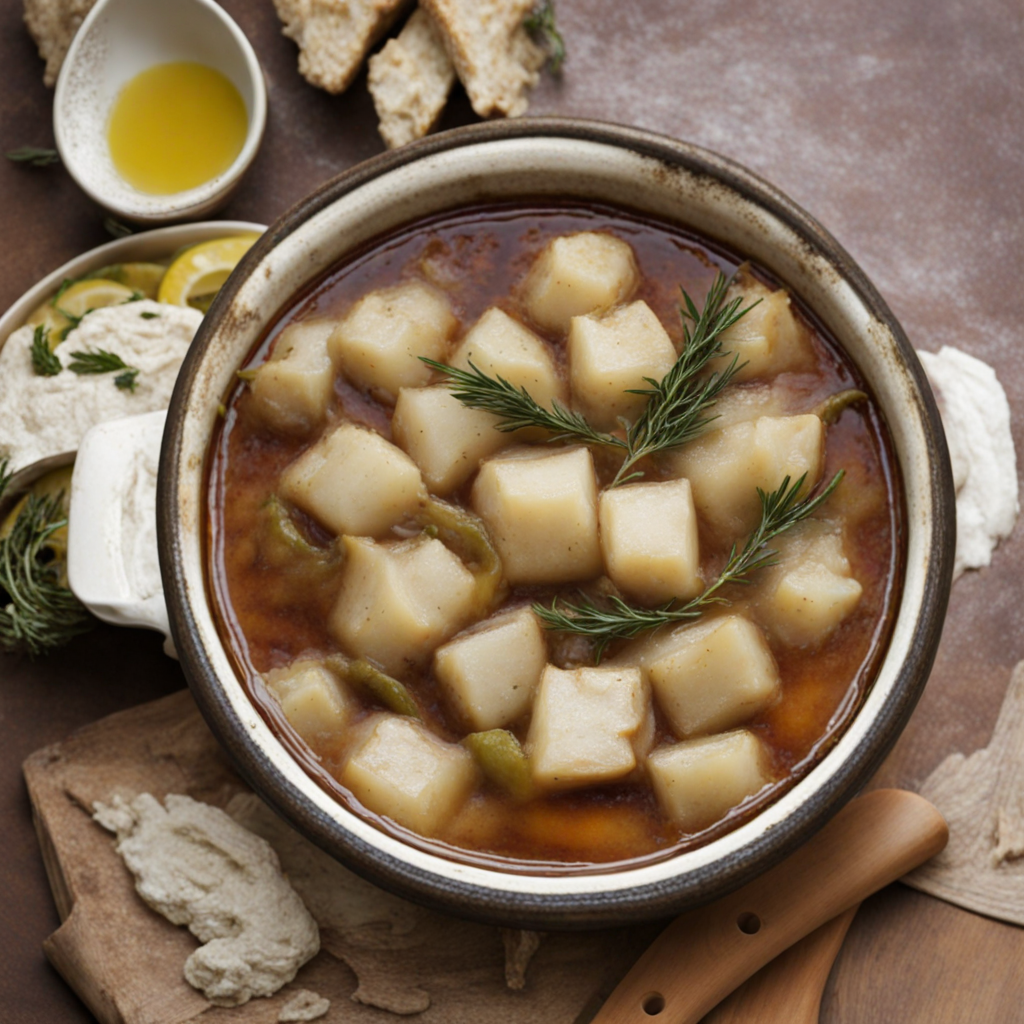Psiadia
Psiadia is a delightful culinary gem from Cyprus that embodies the island's rich agricultural heritage and vibrant flavors. This traditional dish features a unique combination of ingredients, primarily focusing on fresh seasonal vegetables, herbs, and grains. The base of Psiadia is often made from finely chopped vegetables such as tomatoes, bell peppers, and onions, which are sautéed to perfection, allowing their natural sweetness to emerge. The addition of fragrant herbs like parsley, dill, and mint enhances the dish with an aromatic freshness that transports you straight to the sun-kissed Cypriot landscape. What sets Psiadia apart is its incorporation of bulgur or rice, which serves to absorb the flavors of the sautéed vegetables and herbs. This grain component not only adds texture but also makes the dish hearty and satisfying. Often, you may find variations that include legumes like lentils or chickpeas, providing a protein boost while maintaining a wholesome, plant-based focus. The dish is usually seasoned with a sprinkle of salt, pepper, and a dash of lemon juice, balancing the earthiness with a zesty brightness that invigorates each bite. Served warm or at room temperature, Psiadia is a versatile dish that can be enjoyed as a main course or as a side dish to accompany grilled meats or fish. It is commonly garnished with a drizzle of olive oil, which is a staple in Cypriot cuisine, adding richness and a layer of flavor that complements the dish beautifully. Whether you're discovering Psiadia at a local eatery or trying your hand at making it at home, this dish promises a delightful journey into the heart of Cypriot flavors, making it a must-try for any food enthusiast eager to explore new tastes.
How It Became This Dish
The History of Ψηάδια: A Culinary Gem of Cyprus #### Origins Ψηάδια (pronounced "psiadia") is a traditional Cypriot dish with deep roots in the island's history and culinary culture. Its name is derived from the Greek word "ψητός," meaning "roasted" or "grilled," which aptly describes the method of preparation that gives this delicacy its unique flavor and texture. The dish typically consists of small pieces of meat, often lamb or pork, marinated and then grilled over an open flame or charcoal. Its origins can be traced back to the ancient practices of cooking meat over fire, a method that has been a cornerstone of human sustenance since prehistoric times. Cyprus's strategic location in the Eastern Mediterranean has made it a melting pot of cultures and cuisines. Over millennia, the island has been influenced by various civilizations, including the Greeks, Romans, Byzantines, Ottomans, and British. Each of these cultures contributed to the local culinary landscape, and Ψηάδια is no exception. The dish likely evolved from the ancient Greek tradition of outdoor grilling, which was a social activity often associated with communal gatherings and celebrations. #### Cultural Significance Ψηάδια holds a significant place in Cypriot culture, serving not only as a beloved dish but also as a symbol of hospitality and togetherness. It is often served during festive occasions such as weddings, religious holidays, and family gatherings. The act of preparing and sharing Ψηάδια is deeply rooted in the Cypriot way of life, reflecting the values of community and family that are central to the island's identity. One of the most notable aspects of Ψηάδια is its role in the traditional Cypriot meze—a selection of small dishes served as appetizers. Meze reflects the spirit of sharing and conviviality inherent in Cypriot culture. Ψηάδια often finds its place among other meze items, such as olives, cheeses, and various dips, making it an integral part of the dining experience. The dish is usually complemented by local wine or the famous Cypriot spirit, zivania, enhancing the flavors and further enriching the communal atmosphere. The preparation of Ψηάδια is often a family affair, with recipes passed down through generations. Each family may have its own secret marinade, typically made with olive oil, lemon juice, garlic, and a blend of herbs and spices, including oregano and thyme. The importance of these family recipes cannot be overstated, as they hold the memories and traditions of the past, creating a sense of continuity and belonging. #### Development Over Time As Cyprus has evolved, so too has Ψηάδια. The dish has adapted to changing tastes, available ingredients, and modern cooking techniques while retaining its core identity. In the past, Ψηάδια was primarily prepared with simple, locally-sourced ingredients, reflecting the agrarian lifestyle of many Cypriots. Today, while the traditional preparation remains popular, the dish has also embraced contemporary culinary trends. In recent years, there has been a growing interest in regional and traditional cuisines globally, and Cyprus has not been left behind. Chefs and food enthusiasts are revisiting traditional dishes like Ψηάδια, often incorporating modern techniques such as sous-vide cooking or creative presentations while maintaining the essence of the dish. This resurgence has not only rejuvenated interest among locals but has also attracted international attention, highlighting the rich culinary heritage of Cyprus. The popularity of Ψηάδια has also been bolstered by the rise of food tourism in Cyprus. Visitors to the island are eager to experience authentic local cuisine, and Ψηάδια often features prominently on menus in tavernas and restaurants. Many establishments now offer cooking classes or immersive dining experiences, allowing tourists to learn about the preparation of Ψηάδια firsthand, further embedding the dish into the cultural tapestry of Cyprus. Moreover, the dish has seen variations that cater to dietary preferences and trends. Vegetarian and vegan adaptations of Ψηάδια have emerged, substituting meat with marinated vegetables or plant-based proteins while preserving the traditional grilling method. These adaptations reflect a broader global shift toward plant-based diets and sustainability, demonstrating the versatility of this cherished dish. #### Symbol of Cypriot Identity In the context of Cypriot identity, Ψηάδια transcends mere sustenance; it embodies the spirit of the island and its people. The act of gathering around a grill, sharing stories, and enjoying food together is a celebration of life and community. The dish serves as a reminder of the importance of family ties, shared history, and cultural heritage. The significance of Ψηάδια extends beyond the dining table, as it is often featured in cultural festivals and events that celebrate Cypriot traditions. The annual "Cyprus Wine Festival," for instance, showcases local wines paired with traditional dishes like Ψηάδια, celebrating the island's agricultural bounty and culinary arts. Such events reinforce the connection between food and cultural identity, fostering a sense of pride among Cypriots. In recent years, initiatives to preserve and promote traditional Cypriot cuisine have gained momentum, with organizations dedicated to safeguarding culinary heritage. These efforts aim to ensure that dishes like Ψηάδια continue to thrive and evolve, passing on their rich history to future generations. #### Conclusion The journey of Ψηάδια from its ancient origins to its contemporary adaptations reflects the dynamic nature of Cypriot cuisine and culture. As a dish that symbolizes hospitality, community, and familial bonds, Ψηάδια transcends its status as mere food; it is a cultural artifact that tells the story of Cyprus itself. With its deep historical roots, cultural significance, and ongoing evolution, Ψηάδια remains a culinary gem that continues to delight both locals and visitors alike, ensuring its place in the heart of Cypriot tradition for years to come.
You may like
Discover local flavors from Cyprus







